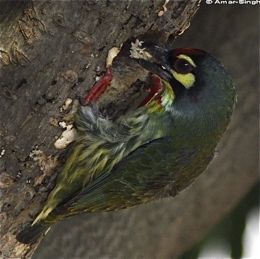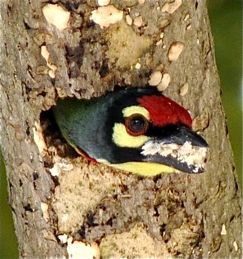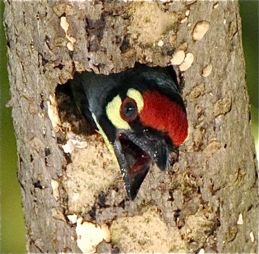“A Coppersmith Barbet (Megalaima haemacephala) was excavating a nesting cavity in a rotting branch of a payung Sumatra of sandbox tree (Hura crepitans) that grows outside one of my neighbour’s house. The branch is angulated at 35-40º and the cavity is about 2.5 metres from the ground. This height is lower than the 4-15 metres that Wells (1999) report for this species. However, Short & Horne (2001) gives the height of cavities as 1.5-15 metres or more.
“The branch has an existing hole higher up that could be an old nest. This tree has been the favourite perch for this bird in my neighbourhood.
“The excavating started on Saturday morning (above). I was careful to watch without disturbing the bird as well as not bringing undue attention – worried some of my neighbours (having known them for years) are not bird sensitive and may damage the nesting. It knew I was watching but tolerated me.
“The Coppersmith Barbet was a very fast worker. I was busy Saturday and could not watch all the time, but from 9 am to noon it was able to excavate a hole large enough for it to fit in partially.
“And by evening it was able to completely enter the hole (above left). It did not seem to take a break. My watching was intermittent throughout the day (from my home and occasionally using the car as a hide), but every time I looked it was at the hole. It tends to collect a lot of wood chips in its mouth (above right) before discarding them somewhere else.
“By Sunday the hole was sufficiently large for the bird to enter and excavate deeper down. It came out periodically to dispose of the wood chips (above left). It was a hot day and the bird was panting at times (above right). It worked almost the whole day, to complete by evening. By Monday it was seldom seen, but then my observation was limited as I was at work most of the time.”
Dato’ Dr Amar-Singh HSS
Canning Garden Home, Ipoh, Perak, Malaysia
12th December 2009
Note:
Barbets generally do not make use of cavities abandoned by other birds but may reuse their old cavities after extending and creating a new opening. If the cavity is not on a vertical trunk or branch, the cavity is excavated on the underside of a slanting branch.
Depending on the softness of the wood and the bill morphology of the barbet concerned, the number of days from start to finish may take 18-30 days (Short & Horne, 2002). This Coppersmith Barbet’s record breaking time in excavating its cavity can be due to the advanced stage of rotting of the branch. There was a large whitish patch on the upper part of the branch, indicating that fungal activity was at an advance stage. It is possible that the branch was already hollow, the barbet only making an opening or enlarging an existing opening.
References:
1. Short, L. L. & J. F. M. Horne, 2001. Toucans, barbets and honeyguides: Ramphastidaer, Capitonidae and Indicatoridae. Oxford University Press. 526 pp.
2. Short, L. L. & J. F. M. Horne, 2002. Family Capitonidae (Barbets). In: del Hoyo, J., A. Elliott & J. Sargatal (eds.), Handbook of the birds of the world. Vol. 7. Jacamars to Woodpeckers. Lynx Editions, Barcelona. Pp. 140-219.
3. Wells, D.R., 1999. The birds of the Thai-Malay Peninsular. Vol. I, Non-passerines. Academic Press, London. 648 pp.













